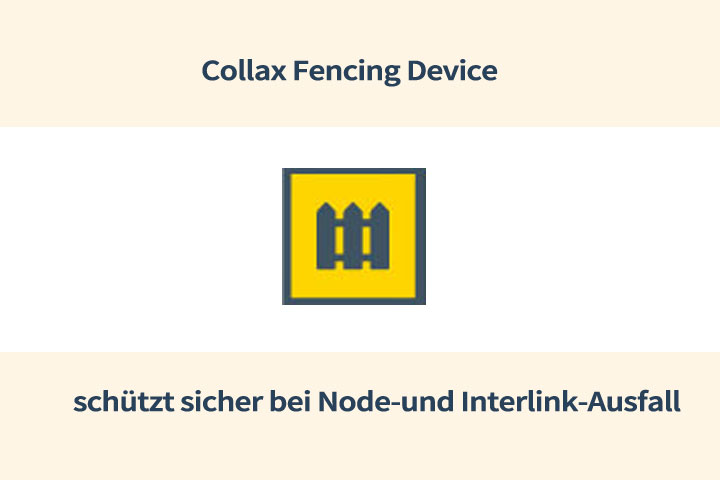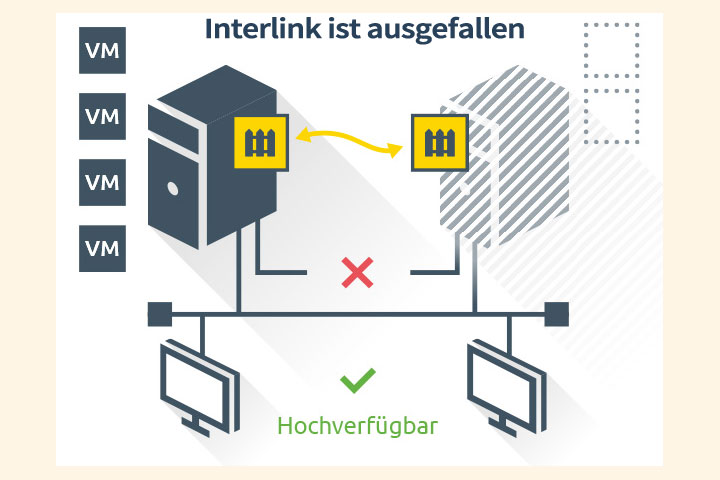Collax Fencing Device
Your protective shield against data loss
Patented technology to protect against data loss
The patented Collax Fencing Device ensures data integrity at all times and under all operating conditions and thus protects against the consequences of Split Brain and Stonith Deathmatch.
Collax Fencing - an effective protection against split brain and deathmatch
Collax’s HA cluster solutions provide secure protection against split brain and deathmatch, preventing cluster nodes from becoming lone warriors in emergency situations.
Such a situation can occur in two cases (see graphic).
-
Node has failed or was switched off unintentionally: The remaining node will take over the control and function of the failed node. This ensures high availability. The prerequisite for this, however, is that the two nodes can continue to communicate with their counterparts.
-
The interconnect connection between the two nodes is interrupted: Both nodes now assume that the other cluster node is no longer available and want to take over its function. The nodes take control of their part of the memory resources that are actually shared. This inevitably leads to data chaos and data loss. A subsequent merging of the data is practically impossible.
What dilemma can that create?
Although a node can determine that its counterpart can no longer be reached, there is no way for it to distinguish between the two states, node failure or interconnect interruption.
If the wrong assumption is made by a node and the wrong state is used as a basis for further measures, this leads either to data loss or to severely limited availability.
The Collax Fencing Device ensures that the functional node completely shuts down the other node. Thus it is clear that the remaining node has control and may take over all functions.
What distinguishes the Collax Fencing Device from conventional solutions?
All common fencing methods rely on a third instance to solve the dilemma described above. Here there are the following possibilities with the associated disadvantages:
- Admin-Fencing: Here the administrator intervenes manually and restores the high availability of the nodes. This results in limited high availability.
- Node quorum: At least three nodes are required for a functioning quorum. In ambiguous cases, there is still a residual risk of severely limited availability or even split brain.
- Quorum with two nodes: For a two-node cluster, at least one quorum service is set up on a computer that must not belong to the cluster. This is cost-intensive, also due to the necessary, well-founded know-how of the administrators. Here, too, there is a danger of unclear cases.
- Quorum via SAN: If the cluster has an external storage, this can be used for the quorum. Likewise the danger of the not clear cases is given.
- Fencing per Stonith: PDUs and lights-out devices must be configured. A deathmatch is still possible.
All alternative methods have in common that a third device must be configured and managed for a two-node cluster, unless the administrator is to be consulted for maintenance of availability or availability restrictions are accepted.
Download Datasheet Collax Fencing Device 116 kBFurther information:
- Effective protection against split brain and Deathmatch
- Independent communication channel
- No admin fencing necessary
- No quorum of three nodes required
- Expandable with Collax Fencing Expander
- Automatic configuration



Data security through spatial separation of the servers
The Collax Fencing Expander ensures maximum data security through the spatial separation of the servers. The data is also secure in the event of serious external influences such as fire or vandalism.
The Collax Fencing Expander features its own power supply and an independent connection via RJ45. The servers can be located in buildings up to 2000 m away.
- Protection against serious external influences (e.g. fire, vandalism)
- Own power supply
- Independent connection via RJ45
- Distance of servers up to 2 km